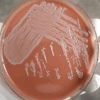Bacterial Flora and Treatment Strategies in Women With Escherichia coli Urinary Tract Infections
- PMID: 38646229
- PMCID: PMC11027953
- DOI: 10.7759/cureus.56552
Bacterial Flora and Treatment Strategies in Women With Escherichia coli Urinary Tract Infections
Abstract
Introduction This study explores the intricate relationship between bacterial flora and the occurrence of Escherichia coli (E. coli) infections in gynecological patients. It aims to provide insights into the various treatment strategies used to effectively manage bacterial pathogens, especially E. coli infections. By conducting a comprehensive analysis of the bacterial flora in gynecological patients, the study highlights the notable presence of E. coli, prompting further investigation into the factors that contribute to its colonization. The objective of the study is to comprehensively investigate and detect urinary tract infections (UTIs) specifically caused by E. coli among gynecological patients. The study aims to delve into bacterial flora prevalence, antibiotic resistance patterns, and potential virulence factors. Through this analysis, the study intends to identify effective strategies for rapid detection and diagnosis of UTIs caused by E. coli by utilizing advanced microbiological and molecular techniques. Furthermore, the study aims to formulate and propose a strategic treatment approach with a particular emphasis on selecting appropriate antibiotics to reduce the risk of severe infections and associated complications. Materials and methods The methodology employed in this study included the isolation and characterization of bacterial strains from clinical samples obtained from gynecological patients. A total of 52 urine specimens were collected from patients with complaints of infection in the urinary tract and infertility. These samples underwent both preliminary and confirmatory microbiological analysis, such as gram staining, biochemical confirmation test, and antibiotic susceptibility, and further proceeded with the multiplex polymerase chain reaction (PCR) technique. The results of PCR and antibiotic susceptibility revealed the specific gene involvement and resistant characteristics of E. coli. Results The findings revealed a total of 32 specimens positive for E. coli, of which 10 patients had infertility complaints and 22 patients had UTIs. The preliminary test, gram staining, showed the gram-negative bacilli E. coli, and the nutrient agar plate revealed smooth circular translucent colonies; MacConkey agar showed pink-colored lactose-fermented colonies; and the blood and chocolate agar plates showed grayish white moist gamma-hemolytic colonies. The biochemical confirmation of E. coli resulted in positive for indole and methyl red tests and negative for Voges-Proskauer and citrate utilization tests. The multiplex PCR analysis confirmed the E. coli strains with the presence of two target genes, stx2d and stx2e. Conclusion To summarize, this study offers valuable insights into the bacterial flora of gynecological patients impacted by E. coli infections, which provides a foundation for the development of precise and efficient treatment strategies. The results emphasize the importance of personalized treatment approaches that consider both the microbiological characteristics of the infection and the evolving landscape of antibiotic resistance. The implication of this research extends to enhancing clinical outcomes and alleviating the burden of E. coli infections in gynecological settings.
Keywords: antibiotic resistance (abr); e.coli; multiplex pcr; treatment strategies; urinary tract infections.
Copyright © 2024, Mahesh et al.
Conflict of interest statement
The authors have declared that no competing interests exist.
Figures





Similar articles
-
Antimicrobial susceptibility patterns of urinary tract infections causing bacterial isolates and associated risk factors among HIV patients in Tigray, Northern Ethiopia.BMC Microbiol. 2024 Apr 27;24(1):148. doi: 10.1186/s12866-024-03297-2. BMC Microbiol. 2024. PMID: 38678188 Free PMC article.
-
Expanded PCR panel for uropathogen identification and treatment recommendations in urinary tract infections.Ther Adv Urol. 2025 Jun 10;17:17562872251342421. doi: 10.1177/17562872251342421. eCollection 2025 Jan-Dec. Ther Adv Urol. 2025. PMID: 40503430 Free PMC article.
-
Prevalence, antimicrobial susceptibility profile, and associated risk factors of uropathogenic Escherichia coli among pregnant women attending Dr. Sumait Hospital Mogadishu, Somalia.Front Public Health. 2024 Jan 24;11:1203913. doi: 10.3389/fpubh.2023.1203913. eCollection 2023. Front Public Health. 2024. PMID: 38328535 Free PMC article.
-
Bacterial characteristics of importance for recurrent urinary tract infections caused by Escherichia coli.Dan Med Bull. 2011 Apr;58(4):B4187. Dan Med Bull. 2011. PMID: 21466767 Review.
-
Sulopenem: An Intravenous and Oral Penem for the Treatment of Urinary Tract Infections Due to Multidrug-Resistant Bacteria.Drugs. 2022 Apr;82(5):533-557. doi: 10.1007/s40265-022-01688-1. Epub 2022 Mar 16. Drugs. 2022. PMID: 35294769 Review.
References
-
- Vaginal Escherichia coli share common virulence factor profiles, serotypes and phylogeny with other extraintestinal E. coli. Obata-Yasuoka M, Ba-Thein W, Tsukamoto T, Yoshikawa H, Hayashi H. Microbiology (Reading) 2002;148:2745–2752. - PubMed
-
- Pathogenic Escherichia coli. Kaper JB, Nataro JP, Mobley HL. Nat Rev Microbiol. 2004;2:123–140. - PubMed
LinkOut - more resources
Full Text Sources
